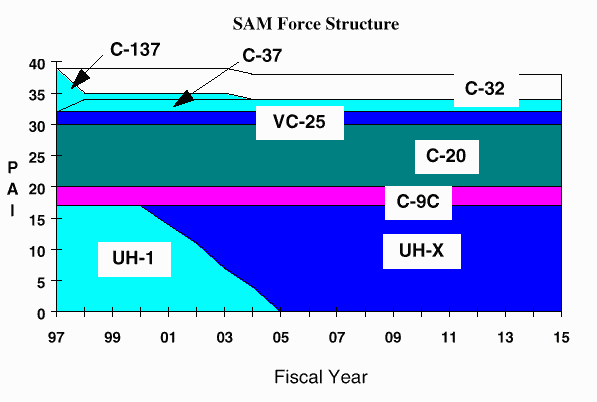



Presidential air transport began in 1944 when a C-54 Skymaster -- the "Sacred Cow" -- was put into service for President Franklin D. Roosevelt. Then came the "Independence," a DC-6 Liftmaster, which transported President Harry S. Truman during the period 1947 to 1953. President Dwight D. Eisenhower traveled aboard the "Columbine II" and "Columbine III" from 1953 to 1961. A 1953 incident where Eisenhower's aircraft was "Air Force 8610" and an Eastern Airlines plane was "8610" created the need to devise a unique call sign. The call sign "Air Force One" was classified during the '50s to identify not only the president's plane, but when he was aboard. In September 1961, it became popularly known when it identified President John F. Kennedy flying aboard his C-118.
In 1962, a C-137C specifically purchased for use as Air Force One, entered into service with the tail number 26000. It is perhaps the most widely known and most historically significant presidential aircraft. Tail number 26000 is the aircraft that carried President Kennedy to Dallas, Nov. 22, 1963, and returned the body to Washington, D.C., following his assassination. Lyndon B. Johnson was sworn into office as the 36th president on board the aircraft at Love Field in Dallas. This fateful aircraft also was used to return President Johnson's body to Texas following his state funeral Jan. 24, 1973.
In 1972 President Richard M. Nixon made historic visits aboard 26000 to the People's Republic of China in February and to the former Union of Soviet Socialist Republics in May.
The SAM fleet is a diverse mix of long, medium, and short-range aircraft, suitable for both large and small passenger loads. Logistics support for SAM aircraft is a combination of military and contractor support. Aircraft maintenance is handled by an Aircraft Generation Squadron and a Maintenance Squadron, as well as CLS for the C-9, C-20, C-32, and C-37. Supply support is a coordinated effort between Base Supply for the H-1, and Contractor Operated and Maintained Base Supply (COMBS) for the VC-25, C-137, and C-20. The C-9 fleet is flown at less than half the C-9 aeromedical evacuation fleet utilization rate. An engine hush-kit program is underway to allow the aircraft to meet FAA Stage 3 noise compliance requirements. The UH-1N aircraft are modified helicopter gunships using 1960�s technology. They surpassed their useful service life of 20 years by 5 years and have not had a structural upgrade/overhaul. The SAM fleet, with the exception of the VC-25 and C-20, is tasked to its limit and is costly to operate. The 89 AW achieves almost perfect mission reliability worldwide through the increasing expenditure of time, effort, and money on maintenance and spare parts fabrication. While they can deliver their distinguished passengers anywhere in the world, the cost of guaranteeing their high-reliability rate continues to increase. With modernization, almost every aspect of SAM can be improved. A study of the SAM is determining the lift requirements and will provide a baseline for future fleet modernization decisions. A modernized fleet will incorporate improvements in range, payload, maintenance reliability/supportability, and the ability to operate independent of ground support equipment. The current fleet is limited from transiting certain airfields due to FAA/ICAO noise restrictions and is required to stop for fuel on a standard transAtlantic mission. Additionally, communications capabilities differ widely among aircraft and between aircraft types, reducing the spectrum of communications available to the DV party while en route. A modernized SAM fleet will enable operations into more airfields with fewer stops at less expense than can be currently realized. The UH-1N is also range limited and cannot complete all of its assigned missions under instrument meteorological conditions. As AMC looks to the future, many modernization alternatives will be considered, including the upgrade of existing systems or the purchase/lease of new aircraft. A replacement program for the C-137 is underway. The C-32A is programmed to begin delivery in FY98. As stated in the AE section of this plan, the C-9A fleet will require modernization in the near future, and the Command should study the feasibility of including the SAM C-9Cs if the specialized airlift fleets are not consolidated. The C-20 fleet is undergoing modernization. All C-20Bs and C-20Hs will receive communications and avionics upgrades. A portion of the C-20B fleet will be replaced with the C-37A. A Statement of Need has also been validated to replace the UH-1N helicopters.
